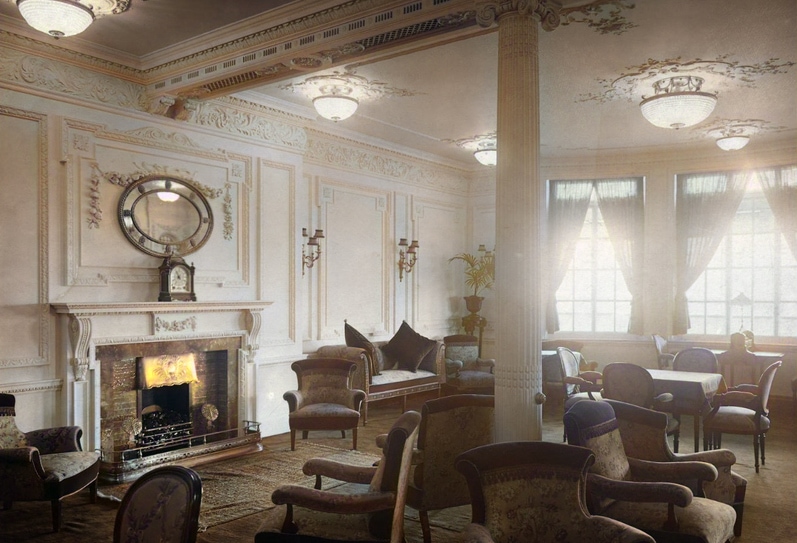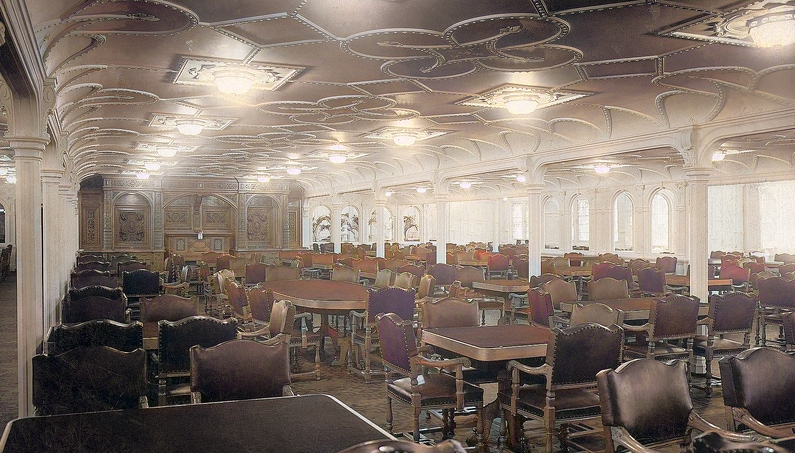If you are interested in this history of the Titanic you may be wondering if she had electricity onboard. The construction of the Titanic started in 1909, the ship set sail in 1912, and at the time she was the most technologically advanced ship in service.
Titanic had two sister ships, the RMS Britannic and RMS Olympic. The technology onboard all sisters was very similar.
Did Titanic Have Electricity?
The Titanic had electricity which was created by four engines. The engines were steam-powered and created 16,000 amps of 100-watt electricity which was used to power the onboard lighting, fans, heating, winches, cranes, and onboard elevators. The Titanic also had backup electrical generators.
It’s estimated that there were around 10,000 electric light bulbs onboard the Titanic.
The below photo is from Titanic’s sister ship Olympic. Due to the fact that the ships were almost identical, there aren’t as many photos of Titanic as her sister Olympic. Photography was expensive and difficult at the time!

Electricity onboard the Titanic was used to power the following:
- Lighting
- Bridge Equipment
- Deck Cranes
- Electrical Baths (In the Turkish Baths/Spa Area)
- Winches
- Elevators
- Loudspeakers/Tannoy Systems
- Fans
- Kitchen Machinery
- Heaters (520 Installed)
- 1500 Electrical Bells
While the Titanic was being built she used power provided from another ship that was moored alongside her for this purpose. When cruise ships are under construction they don’t use their own power. The ship was called Jackal and built in 1885.
The Titanic’s Cables
The cables used on the Titanic were covered with tinned copper.
When needing to pass through a watertight compartment the cables would be collected together and the area covered with a material called bitumen, this ensured that water couldn’t get through. Bitumen is commonly used for road services or in roofs.
In the first class cabins there was an electric outlet in addition to the usual lighting that could be used for a small light or a fan. Cabins in lower grades did still have the usual lighting but no extra outlet.
For many people cruising on the Titanic, particularly in lower grade cabins the use of technology and electricity onboard was one of the selling points of the ship.
How did The Titanic Generate Electricity?
The Titanic generated electricity by using four 400-kilowatt steam-driven engines and dynamos which had an output of 16,000 amps of direct current at 100-volts. This was the same amount of electricity as a small town at the time. In day-to-day service, only 2 of the 4 engines would be in operation.
This gave the Titanic enough flexibility so that one engine could be out of order or being worked on without any effect on the ship. A third engine could be turned on if demand for electricity was high, such as at peak times in the evenings.
Where Were The Steam-Powered Generator Engines Located?
The four engines were located on the lowest deck called the Tank Top. They were behind their own watertight door in their own compartment.
They were at the back of the ship as this was far from passenger accommodations and provided easy access for the crew. On modern cruise ships, the passenger cabins extend from aft to bow as the onboard experience isn’t affected as much by the movement on the ship.
To learn more about the amount of movement you can expect to feel on a modern cruise ship, check out this post: You May Feel Movement on a Cruise Ship – Here’s When and Why
How Did The Titanic Control The Electricity it Generated?
The Titanic had a HUGE electricity control panel that was 30-40 feet in length. The panel controlled how electricity was used around the ship.
A modern smartphone or laptop would easily be able to complete all tasks that this large control panel managed.
Titanic Used Electricity to Manage Shipboard Time
One of the most important tasks that Titanic used electricity for was to keep all onboard clocks showing the correct time.
The Titanic had 24 clocks located around the ship in a ‘master and slave’ setup. This meant that when the time was moved forward, or backward on the master clock this would update the clocks around the ship. This was done by the master clock releasing electrical impulses that moved the other clocks forward.
This meant that crew didn’t have to individually change all clocks. As the Titanic was sailing across the Atlantic this meant multiple time zone changes every trip.

Did Titanic Have Back up Power?
The Titanic had emergency generators that were steam-driven. There were 2 30 kilowatt dynamos that could be used in case of emergency. These dynamos provided the ship with emergency lighting which was on a different circuit to the main lighting onboard.
These emergency generators were located 4 decks above the primary engines and were actually above the waterline.
Emergency lighting was designed to provide minimal levels of lighting in case of an emergency and to provide power to the bridge.
When Did The Power go Out During The Sinking of The Titanic?
The lights on the Titanic went out completely at 2 am, the ship sank fully at 2.18am. Due to the location of the generators the power was one of the last things to go out when the Titanic sunk.
“She had stood out clear as day with her rows of electric lights burning, when the boilers broke away she was, of course, plunged into absolute darkness. Although her huge black outline was still perfectly distinct.”
Titanic survivOr – source.
The engines were located at the back of the ship and the back of the ship was the last part to go down. This section of the ship didn’t flood until the ship broke in half.
The pipes that bought steam from the generators would have been torn in two and at this point, the main generators would have slowly failed.
Although the emergency generators were higher up they would soon meet the same fate as the ship being broken in half would have broken the steam pipes that powered the generators.
At the time of the accident and the sinking, the backup generators and backup lights would have already been on. This was customary at the time so that if anything did happen at night the ship wouldn’t be plunged into darkness.
As the ship went down the lights slowly faded from a bright white to a red colour, survivors report that the lights of the ship were still on during the last hour of the sinking.
How Did Titanic Compare to Modern Cruise Ships?
At the time of her launch Titanic was the largest and most complex ship to set sail. A lot has changed in ship design since the Titanic set sail. To learn about how the Titanic compares to the Royal Caribbean fleet, check out this post next:

Free Insiders Cruise Line Guide
Ever wondered how the mainstream cruise lines compare? Cruise lines won’t tell you this, but I will.
This FREE guide shows you everything you need to know to find your perfect cruise line.
